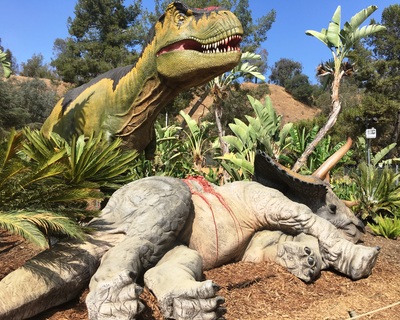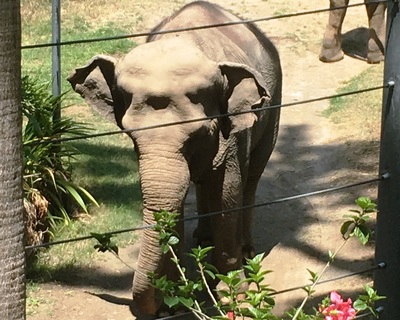Dinosaurs: Unextinct at the L.A. Zoo
|
|
"Baby Dinosaur Display Hatched at LA Zoo"
By: Melissa Wen July 8, 2016 Thank you to NBC4 Los Angeles & Melissa Wen for using our video during the NBC4 News at 4 PM, on July 8, 2016, & in their article! |
"Parks and Cons" YouTube Channel
Photo Gallery
SEVEN BABY DINOSAURS "HATCH" AS DIABLOCERATOPS FAMILY EXPANDS AT
DINOSAURS: UNEXTINCT AT THE L.A. ZOO EXHIBIT
Spectacular Life-Size, Animatronic Prehistoric Creatures Take Visitors Back in Time for Colossal Adventure
Through October 31, 2016, 10 am to 4 pm
Los Angeles Zoo and Botanical Gardens
DINOSAURS: UNEXTINCT AT THE L.A. ZOO EXHIBIT
Spectacular Life-Size, Animatronic Prehistoric Creatures Take Visitors Back in Time for Colossal Adventure
Through October 31, 2016, 10 am to 4 pm
Los Angeles Zoo and Botanical Gardens
Seven adorable life-like baby Diabloceratops dinosaurs made their debut on Friday, July 8 among a pack of prehistoric creatures residing in a once off-limits corner of the Los Angeles Zoo at DINOSAURS: UNEXTINCT AT THE L.A. ZOO, a spectacular exhibit produced and presented by the Greater Los Angeles Zoo Association, continuing through October 31, 2016, 10 am to 4 pm. Nesting since April 15 when the exhibit opened to the public, the newborns – three girls and four boys – "hatched" beside their ferociously protective mom, who is one of 17 animatronic dinosaurs in the exhibit, all – including the little ones -- brought to life with electronic "brains."
The exhibit's dinosaurs take visitors back in time for a colossal adventure, providing a rare chance to discover a lost world from millions upon millions of years ago while warning about the very real threat of extinction faced today by many endangered species. Among the exhibit's features is a Fossil Dig, a Stegosaurus robot with controls guests can operate to make the creature move; a climbable Pachyrhinosaurus; and a free downloadable augmented reality app (visit www.lazoo.org/dinos) to access special content, including 3-D views of all the dinosaurs. The experience offers gargantuan levels of awe, as well as plenty of "aha"s, with fascinating facts about the prehistoric era, the featured dinosaurs and their similarities to L.A. Zoo animals. Best of all, entry to Dinosaurs: Unextinct at the L.A. Zoo (#DinosAtTheLAZoo) is just $5 per person in addition to regular Zoo admission, and free for wee ones under age two.
Guests embark on this must-see, self-guided stroll along a trail through lush landscaping with foliage similar to the earliest known trees and plants at the time dinosaurs roamed the earth, among them ferns, cycads, conifers and ginkos. The exhibit represents a staggering array of dinosaur anatomic shapes and sizes, ranging in heights up to almost 22 feet, lengths of just over 21 feet and weights topping 6,700 pounds, from locations around the earth and geological eras spanning 65 to 200 million years ago. Visits with the creatures, all boasting an extensive range of motion in a manner experts believe the animals would actually have moved, begin with a Suchomimus, complete with a fierce crocodile-like mouth, from the Cretaceous period some 110 million years ago, followed by a Brachiosaurus, from the Jurassic period 156 million years ago, whose 18-foot-long neck required a gigantic heart to pump blood up to the top. Next, guests encounter two Coelophysis dinosaurs, from the Triassic period 210 million years ago; aCitipati from the late Cretaceous period, which used its feathers to protect and warm its eggs, just like modern-day birds do; and a Carnotaurus, a bipedal carnivore covered in small scales and bony lumps from the late Cretaceous period. More dinosaurs include an Edmontonia, an herbivore with heavy body armor to defend itself, from the late Cretaceous period; and a Utahraptor, the alpha predator of the early Cretaceous period 124 million years ago, whose most unique feature was an extra-long, sickle-shaped claw on the second digit of each foot used to pin down and tear apart prey. Dinosaur families are represented by a Dilophosaurus and baby Dilophosaurus, fast moving bipedal carnivores from the Jurassic period 201 million years ago; and the Diabloceratops and its five babies, representative of the dinosaur from the late Cretaceous whose name means – and aptly describes – its "devil-horned face. Finally, no remarkable dinosaur exhibit would be complete without a Tyrannosaurus, better known as a T-Rex, one of the largest and most powerful dinosaurs, from the Cretaceous period 65 million years ago. Its unfortunate prey, an iconic Triceratops from the Cretaceous period 72 million years ago, lies at the T-Rex's feet.
Along the way, visitors encounter a Fossil Dig where they can brush away sand to uncover "bones" made from a fiberglass mold taken from an actual juvenile Maiasaura fossil, a large, herbivorous hadrosaurid that lived in the area currently covered by Montana during the upper Cretaceous period about 76 million years ago. Other "don't-miss" fun includes a stop at a Stegosaurus robot with controls guests can operate to make the creature move, and a hashtag-worthy, dino-size photo op featuring a Pachyrhinosaurus, a dramatic-looking cousin of the Triceratops, with massive flattened growths over its nose.
Accompanying the exhibit is a free downloadable Dinosaurs: Unextinct at the L.A. Zoo augmented reality app providing an opportunity to interact up-close with each dinosaur by "unlocking" an animated model when pointing a digital device at a target image. A link to download the app can be found at www.lazoo.org/dinos. Users can animate the dinosaur on their screen, making it walk and run. Included in the AR app is a dino quiz, where visitors can test their dino knowledge. After completing the quiz, visitors are rewarded with a small gift at the dino gift shop. The app also features fact sheets and a bonus AR animal: the California Condor, a species that the L.A. Zoo is helping bring back from the brink of extinction, a process that guests can learn more about at the interactive California Condor Rescue Zone indoor learning space, which is adjacent to the dinosaur exhibit and open every weekend plus weekdays throughout the summer. (Check www.lazoo.org for schedule.)
The dinosaurs for the Los Angeles Zoo's exhibit are provided by Billings Productions, one of only a handful of companies in the world that produce life-size, animatronic dinosaurs based on today's best science for traveling and permanent exhibits.
The Los Angeles Zoo is located at the junction of the Ventura (134) and Golden State (5) freeways in Griffith Park. 5333 Zoo Drive, Los Angeles, CA 90027. Free parking is available. For tickets and additional information, call (323) 644-6001 or visit lazoo.org/dinos For general information about the Zoo, call (323) 644-4200. #DinosAtTheLAZoo
The exhibit's dinosaurs take visitors back in time for a colossal adventure, providing a rare chance to discover a lost world from millions upon millions of years ago while warning about the very real threat of extinction faced today by many endangered species. Among the exhibit's features is a Fossil Dig, a Stegosaurus robot with controls guests can operate to make the creature move; a climbable Pachyrhinosaurus; and a free downloadable augmented reality app (visit www.lazoo.org/dinos) to access special content, including 3-D views of all the dinosaurs. The experience offers gargantuan levels of awe, as well as plenty of "aha"s, with fascinating facts about the prehistoric era, the featured dinosaurs and their similarities to L.A. Zoo animals. Best of all, entry to Dinosaurs: Unextinct at the L.A. Zoo (#DinosAtTheLAZoo) is just $5 per person in addition to regular Zoo admission, and free for wee ones under age two.
Guests embark on this must-see, self-guided stroll along a trail through lush landscaping with foliage similar to the earliest known trees and plants at the time dinosaurs roamed the earth, among them ferns, cycads, conifers and ginkos. The exhibit represents a staggering array of dinosaur anatomic shapes and sizes, ranging in heights up to almost 22 feet, lengths of just over 21 feet and weights topping 6,700 pounds, from locations around the earth and geological eras spanning 65 to 200 million years ago. Visits with the creatures, all boasting an extensive range of motion in a manner experts believe the animals would actually have moved, begin with a Suchomimus, complete with a fierce crocodile-like mouth, from the Cretaceous period some 110 million years ago, followed by a Brachiosaurus, from the Jurassic period 156 million years ago, whose 18-foot-long neck required a gigantic heart to pump blood up to the top. Next, guests encounter two Coelophysis dinosaurs, from the Triassic period 210 million years ago; aCitipati from the late Cretaceous period, which used its feathers to protect and warm its eggs, just like modern-day birds do; and a Carnotaurus, a bipedal carnivore covered in small scales and bony lumps from the late Cretaceous period. More dinosaurs include an Edmontonia, an herbivore with heavy body armor to defend itself, from the late Cretaceous period; and a Utahraptor, the alpha predator of the early Cretaceous period 124 million years ago, whose most unique feature was an extra-long, sickle-shaped claw on the second digit of each foot used to pin down and tear apart prey. Dinosaur families are represented by a Dilophosaurus and baby Dilophosaurus, fast moving bipedal carnivores from the Jurassic period 201 million years ago; and the Diabloceratops and its five babies, representative of the dinosaur from the late Cretaceous whose name means – and aptly describes – its "devil-horned face. Finally, no remarkable dinosaur exhibit would be complete without a Tyrannosaurus, better known as a T-Rex, one of the largest and most powerful dinosaurs, from the Cretaceous period 65 million years ago. Its unfortunate prey, an iconic Triceratops from the Cretaceous period 72 million years ago, lies at the T-Rex's feet.
Along the way, visitors encounter a Fossil Dig where they can brush away sand to uncover "bones" made from a fiberglass mold taken from an actual juvenile Maiasaura fossil, a large, herbivorous hadrosaurid that lived in the area currently covered by Montana during the upper Cretaceous period about 76 million years ago. Other "don't-miss" fun includes a stop at a Stegosaurus robot with controls guests can operate to make the creature move, and a hashtag-worthy, dino-size photo op featuring a Pachyrhinosaurus, a dramatic-looking cousin of the Triceratops, with massive flattened growths over its nose.
Accompanying the exhibit is a free downloadable Dinosaurs: Unextinct at the L.A. Zoo augmented reality app providing an opportunity to interact up-close with each dinosaur by "unlocking" an animated model when pointing a digital device at a target image. A link to download the app can be found at www.lazoo.org/dinos. Users can animate the dinosaur on their screen, making it walk and run. Included in the AR app is a dino quiz, where visitors can test their dino knowledge. After completing the quiz, visitors are rewarded with a small gift at the dino gift shop. The app also features fact sheets and a bonus AR animal: the California Condor, a species that the L.A. Zoo is helping bring back from the brink of extinction, a process that guests can learn more about at the interactive California Condor Rescue Zone indoor learning space, which is adjacent to the dinosaur exhibit and open every weekend plus weekdays throughout the summer. (Check www.lazoo.org for schedule.)
The dinosaurs for the Los Angeles Zoo's exhibit are provided by Billings Productions, one of only a handful of companies in the world that produce life-size, animatronic dinosaurs based on today's best science for traveling and permanent exhibits.
The Los Angeles Zoo is located at the junction of the Ventura (134) and Golden State (5) freeways in Griffith Park. 5333 Zoo Drive, Los Angeles, CA 90027. Free parking is available. For tickets and additional information, call (323) 644-6001 or visit lazoo.org/dinos For general information about the Zoo, call (323) 644-4200. #DinosAtTheLAZoo





































































































